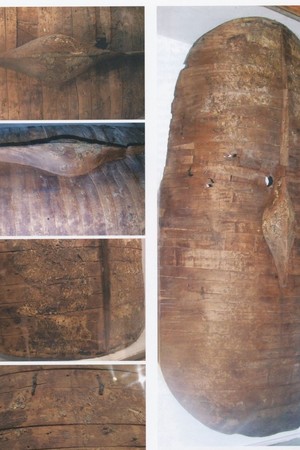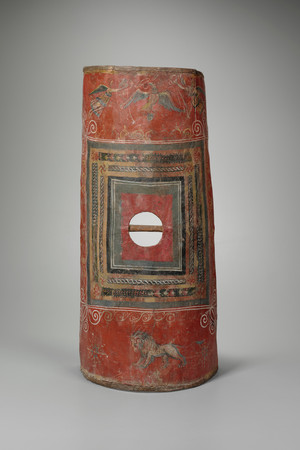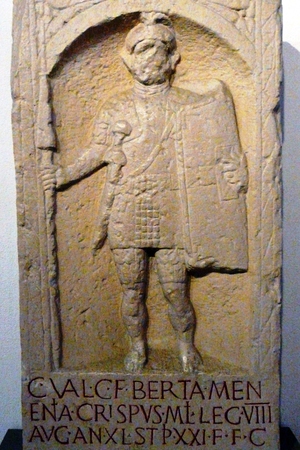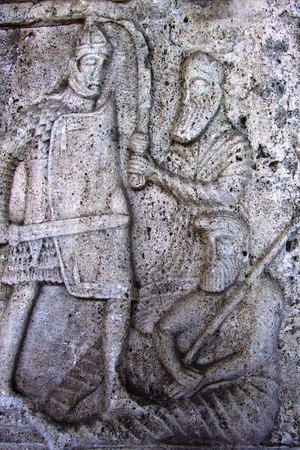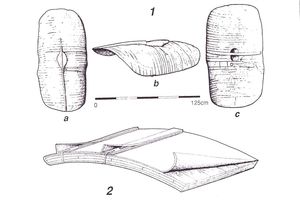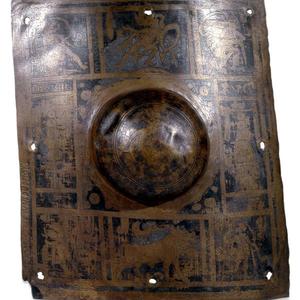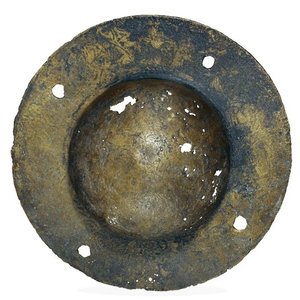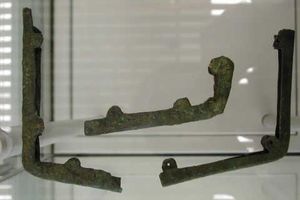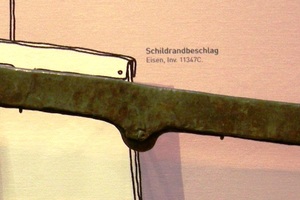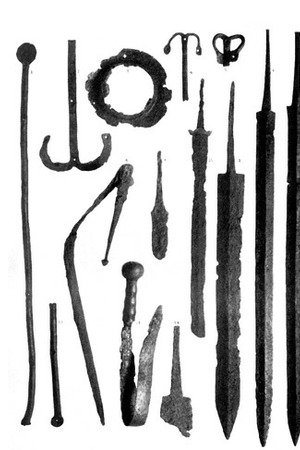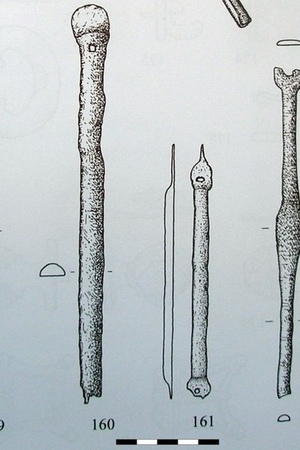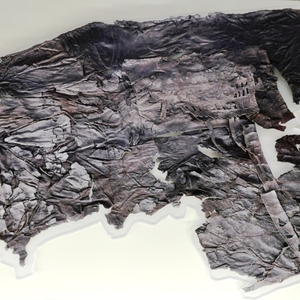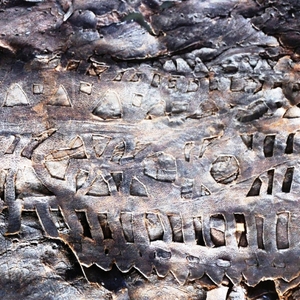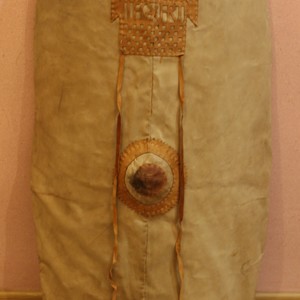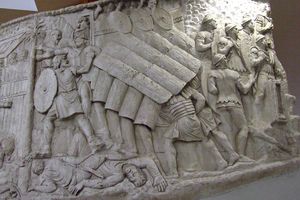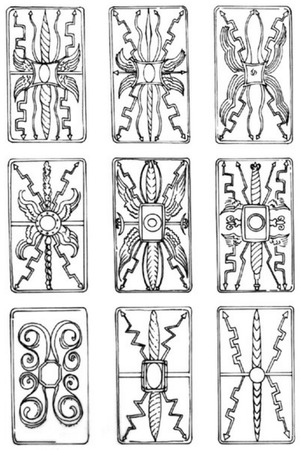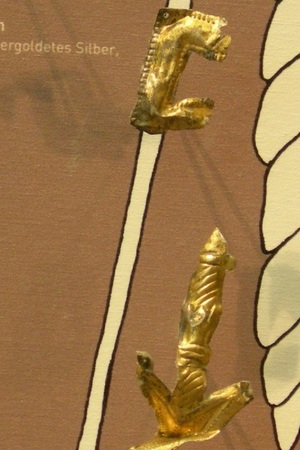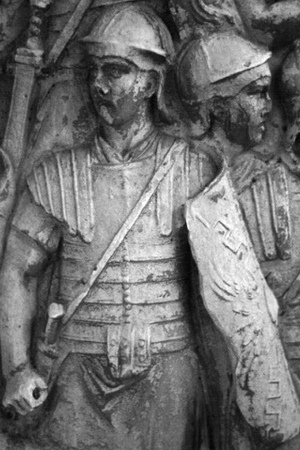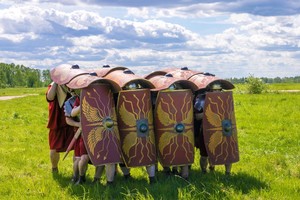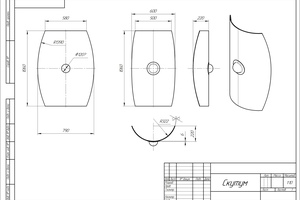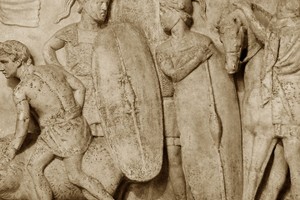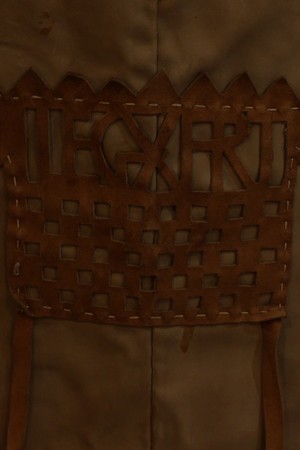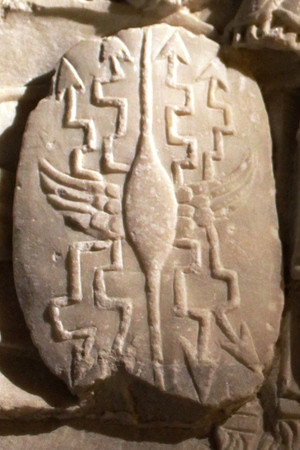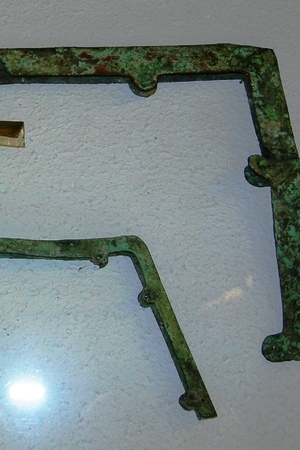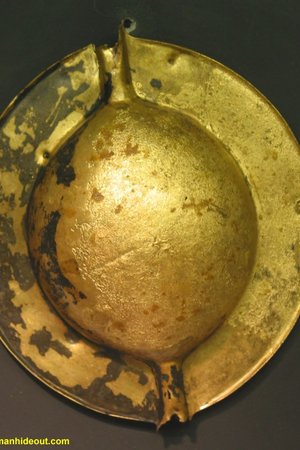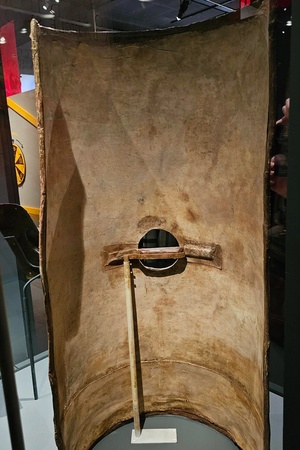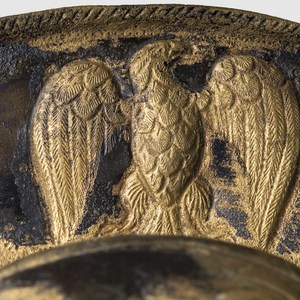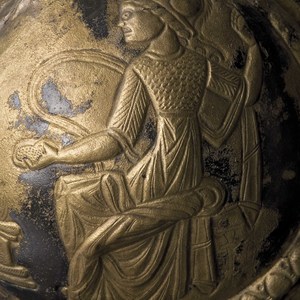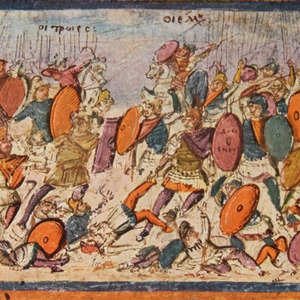Scutum
The scutum (Latin: Scutum, plural: Scuta) is a type of large or tower shield widely used in antiquity, initially by some ethnic groups of the Italian peninsula and later, from the 4th century BC, by the Roman army. Initially, scuta were elongated and oval, but by the 1st century BC, they had evolved into the rectangular and semi-cylindrical shape most commonly associated with legionary shields by modern audiences. It is worth noting that the scutum was not the only shield used in the Roman army; there were several types of shields used by different branches of the military. However, the scutum became the most famous, becoming a symbol of Rome and its mighty legionnaires.
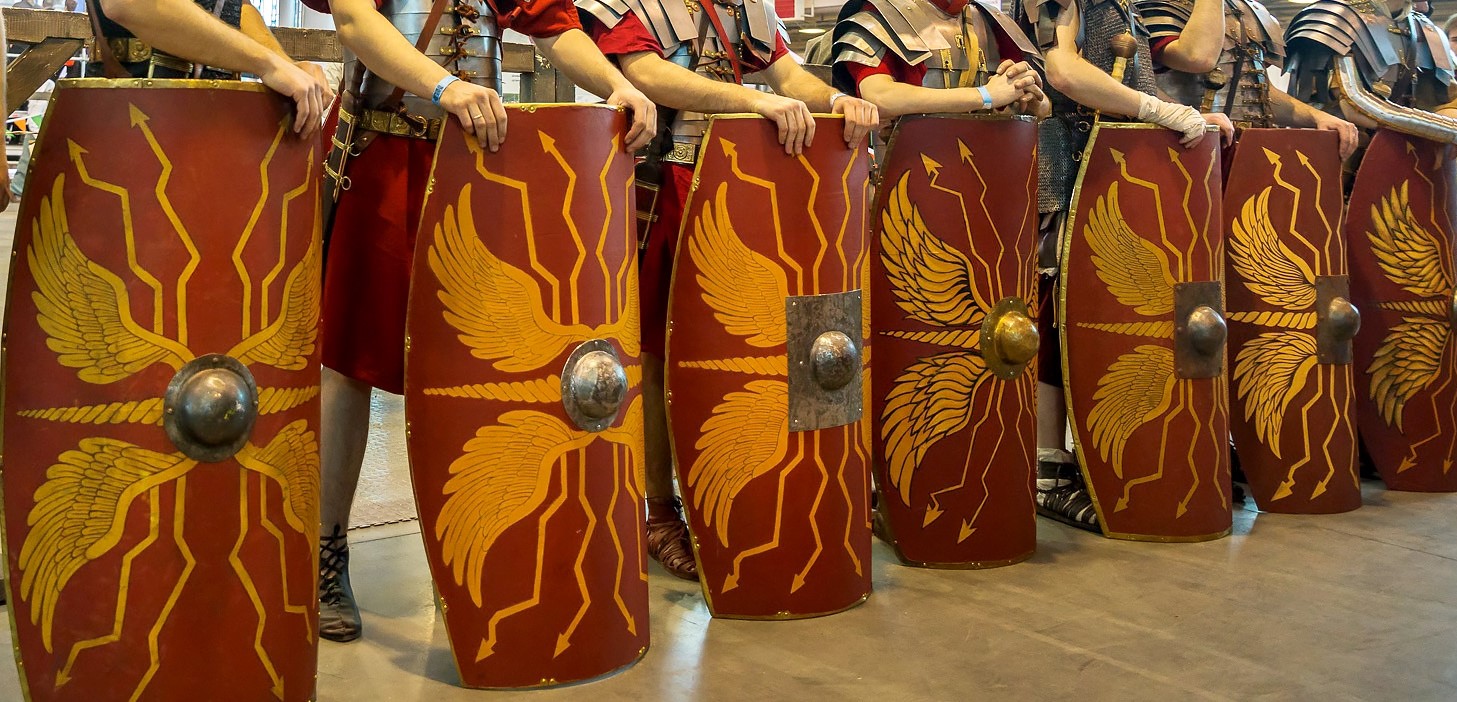 Legio X Fretensis legionnaires with scutums, reenactment
Legio X Fretensis legionnaires with scutums, reenactment
History
There is an opinion among historians, that the Romans adopted Scutum while getting rid of hoplit’s phalanx and adopting maniples. That was the tactics which was introduced during Samnites wars (mid – end IV century BCE.). Before that, roman soldiers used round Clipeuses, which were more similar to early hoplones. Allegedly during these wars Romans did borrow scutums from Samnites. Clypeus — is a round shields, similar to the earlier goplon, and allegedly during these wars, the Romans took over scutum from the Samnites.
This theory is based on the works of several ancient writers. However, the ancient Roman historian Livy (54 BC - 17 AD) noted that elongated shields, along with manipular tactics, appeared at the beginning of the 4th century BC, before the Samnite Wars. The ancient Greek writer and philosopher Plutarch (46 - 127 AD) mentioned the use of a shield similar to the early scutum in the Battle of 366 BC in his "Parallel Lives". French archaeologist P. Coussin asserted that the scutum was used long before the Samnite Wars and was not borrowed from the Samnites.
An image of the oval scutum can be found on the reliefs of the altar of the commander Gnaeus Domitius Ahenobarbus (died 104 BC). A similar scutum was found in 1900 in the small Egyptian town of Kasr el-Harit, near the Fayum Oasis on the Nile (Fayum scutum). By the beginning of the civil wars, the shape of the scutum changed, with rectangular and barrel-shaped variants existing simultaneously. Due to the inaccuracy of scuta depictions on reliefs, it is impossible to assert the dominance of any form, so both variants are considered used.
Scuta were mainly used by legionaries. The Praetorians had their own variation of scutum. Iad their own scutum, which retained its previous oval shape, unlike the "general" variant. Legion’s officers: optiones and centuriones presumable also had scutums. "Skaeva, who lost one eye, wounded in the thigh and shoulder, with a scutum pierced (with arrows) in 120 places, continued to hold the fortress gates under his control..." — this mention of the centurion Cassius Skaeva, whose feat at the Battle of Dyrrhachium (48 BC) was recorded by Julius Caesar himself. Later the herois deed was retaled by Gaius Suetonius Tranquillus. More that, gladiators used scutums. Sometimes their shortened form, for example provocators.
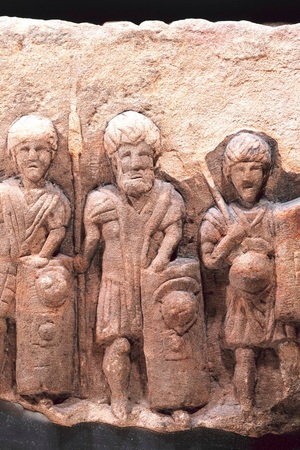 Bas-relief from sand stone, depicting three legionaries with sctuums. Found in Culladia cuneiferellus castra, Antonine Wall, Scotland. Reposited in national Museum of Scotland. (II century CE)
Bas-relief from sand stone, depicting three legionaries with sctuums. Found in Culladia cuneiferellus castra, Antonine Wall, Scotland. Reposited in national Museum of Scotland. (II century CE)By the 3rd century AD, scuta seem to disappear from use. Archaeological findings from the fortress of Dura-Europos indicate that oval or round shields, which were no longer semi-cylindrical but convex or flat, were predominant among the Romans during this period. The word "scutum" survived the fall of the Roman Empire and remained in the military terminology of the Eastern Roman Empire. Even in the 11th century AD, the Byzantines called their heavy infantry "scutati" (Greek: Σκυτατοί).
Structure of the scutum
Polybius describes the scutum in his "Histories": "...The Roman defense consists primarily of the shield (scutum), the convex surface of which is two and a half feet wide and four feet long, with a thickness at the edge equal to the width of a palm. It consists of two glued layers of wooden strips (planks), the outer surface of which is covered with canvas and calfskin. Its top and bottom edges are reinforced with iron, protecting it from blows and damage when placed on the ground. An iron shield boss (umbo) is attached to it, which deflects the most terrible blows from stones, spears, and heavy projectiles in general...". This description takes an early 2nd century BC shield as an example.
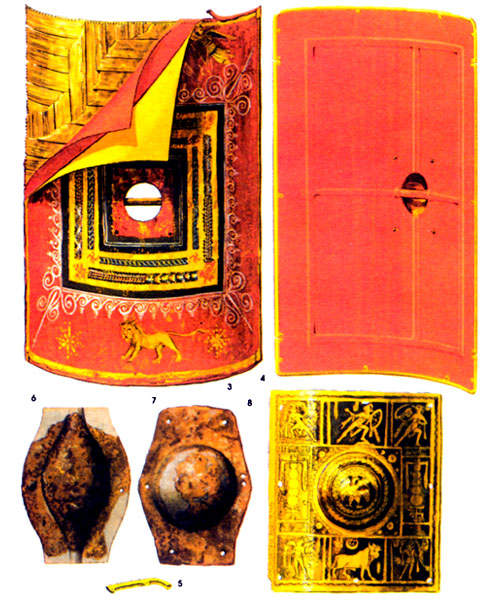 Structure of the scutum form Dura-Europas
Structure of the scutum form Dura-Europas
Basis
The construction of the scutum core remained almost unchanged throughout its use in the Roman army: several (usually 9-10) wooden strips 6-10 cm wide were laid out longitudinally, with thinner strips glued perpendicularly on both sides (outside and inside the shield). This created a three-layer wooden base about 6 mm thick. Initially, the base was covered with felt, and by the time of the Republic, it was covered with calfskin and canvas, with the edges reinforced with iron or bronze, sometimes leather. A round hole was cut in the center for the handle, covered by an umbo, initially made of wood and spindle-shaped, but during the Republic, it became iron or bronze and rectangular.
Umbo
The umbo protected the legionary's hand by covering the hole in the center of the scutum where the handle was attached. Initially, on oval scuta, umbos were wooden, spindle-shaped, and vertically attached along the shield's height. These umbos likely also increased the overall structural strength of the shield. An example of a spindle-shaped umbo is well visible on the Fayum scutum.
By the time of the Republic, the change in shield shape to rectangular led to changes in umbos. They were made of iron, bronze, or brass, became smaller, and took on a round, rectangular, or hexagonal shape. The center of the umbo had a round protruding part covering the handle hole. Sometimes umbos were decorated with embossing.
Edging
To enhance protective properties and overall strength, the edges of scuta were reinforced with iron, brass, or bronze. There was also a variant with leather edging (scutum from Dura-Europos).
According to Polybius, early scuta were edged only at the top and bottom to protect against upper blows and damage when placing the shield on the ground, leaving the side edges unreinforced. Later, the shield was edged around the entire perimeter, significantly increasing its protective properties and allowing it to withstand severe slashing blows, such as those that could be inflicted by a falx (a weapon of the Dacian and Thracian tribes). This also increased the scutum's overall durability and extended its service life.
Grip
In the center of the scutum, covered by the umbo, was the handle. Unlike many medieval shields, the scutum's handle was mounted horizontally, which was the most convenient considering the shield's overall construction. Handles were made of iron, mostly elongated cylindrical, flattened on the sides where holes were punched to secure the handle to the shield base with nails. On earlier scuta, the handle could be the central part of a transverse rib fixed horizontally on the inner surface.
Tegumentum
Tegimentum (Latin: tegimentum - covering, shelter, sheath) - a leather cover put on a scutum during long marches. It served to provide additional protection for the scutum from moisture in bad weather, thereby extending the shield's service life. Typically, it was made from tanned calfskin. A separate leather tag called a tabula ansata (Latin: small tablet with handles) was sewn onto the tegimentum, indicating the legion to which the scutum's owner belonged. It is also worth noting that such a mark was also applied to the shield itself if it was provided by the legion's insignia, indicating the legion and cohort of the shield's owner.
Combat Use of the Scutum
Considering the shield's shape, the handle's position, and the way legionaries wore their swords on the right side, we conclude that the scutum was held by legionaries not in front of the chest, like most medieval shields, but along the left side, covering the body from knee to shoulder. This allowed the fighter to press the enemy in a tight formation by leaning on the shield while delivering quick thrusting sword strikes from beneath the protection. According to Polybius, the scutum gave the Romans an advantage in close combat against the Carthaginians during the Punic Wars: "Their equipment gives them increased protection and confidence, due to the size of their (Romans') shields."
The unique shape of the scutum allowed legionaries to use it to form various battle formations designed to protect against arrows and other projectiles both in offense and defense. The most famous of these formations is the "tortoise" (Latin: Testudo), which uninformed people often use to refer to other Roman formations, such as "Tela" or "Murus." These formations were often used during Roman sieges, allowing legionaries to approach city walls and fortifications safely, being almost completely protected from the arrows and stones of the besieged.
The Jewish historian Josephus (37-100 AD) writes about the use of the scutum during a siege. In his treatise "The Jewish War," he describes the siege of Jerusalem in 70 AD: "The Jews defended themselves from the height of the galleries and repeatedly repelled attacks on the walls, but were forced to retreat under heavy fire. Then the Romans formed what is called a tortoise, consisting of the front soldiers firmly pressing their shields against the walls, those following pressing their shields against the preceding ones, and so on. Arrows falling on this canopy slid off the surface without any effect: the soldiers could now calmly undermine the wall and were already making preparations to set the temple gates on fire."
Decoration of Scutum
Scutums were often decorated: a so-called "digma" (Latin: Digma) was applied to their fabric covering - a drawing depicting lightning bolts, wings, wreaths, and sometimes indicating the unit's number and name. According to Tacitus, with the help of a digma, specific units could be identified since each legion or auxiliary unit had its unique digma. Tacitus describes an incident during the second battle of Bedriacum (69 AD), where two soldiers from Vespasian's legions took shields with digmas of Vitellius's hostile legions and carried out a diversion in the rear, damaging enemy catapults.
It is also suggested that the surface of the scutums could be adorned with various iron or bronze overlays, as confirmed by archaeological finds of bronze fragments imitating the shape of a digma.
Reenactment
In reconstruction, our legion uses barrel-shaped scutums with a red base color and a digma from the early second century. The scutum itself is made with a height of 106 cm, a width of 60 cm in the central part, and 50 cm at the top and bottom edges. The shield's depth in the curve is 22 cm, and the thickness is 6 mm. The boss is iron, round or rectangular. The shields are bordered with brass.
The field of the shield is red, corresponding to archaeological finds of shields from Masada, which was besieged by the Tenth Legion in 70-73 AD. The digma is yellow, an example of which is presented on Trajan's Column (early 2nd century AD). The digma depicts four wings symbolizing the messengers of Jupiter, bringing lightning and thunder to the enemies, also depicted on the shield. The thunder is symbolized by the intricate columns forming the central part of the digma's composition.
Related topics
Legionnaire, Hoplon, Clipeus, Praetorian Guard, Centurion, Gladiator, Provocator
Literature
- Hilary & John Travis. Roman Shields: historical development and reconstruction. Amberley Publishing, Gloucestershire, GL5 4EP, 2014.
- JAMES CURLE, F.S.A. SCOT., F.S.A. A Roman frontier post and it's people. The fort of Newstead in the Parish of Melrose. Glasgow, MDCCCCXI. Originally published by JAMES MACLEHOSE AND SONS for the Society of Antiquaries of Scotland.
- Joseph Aviram, Gideon Foerster, Ehud Netzer, Guy D. Stiebel MASADA VIII. The Yigael Yadin Excavations 1963–1965. Final Reports. ISRAEL EXPLORATION SOCIETY. THE HEBREW UNIVERSITY OF JERUSALEM. JERUSALEM, 2007.
- "The Arms and Armour from Dura-Europos, Syria : Weaponry Recovered from the Roman Garrison Town and the Sassanid Siegeworks during the Excavations, 1922-37". University College London (University of London).
- Couissin P., Les armes romaines, pp. 224.
- Josephus. "The Jewish War" / translated by Ya. L. Chertka in 1900, with an introduction and translator's note. Vekhi Library, 2004.
- Livy Titus. Istoriya Rima ot osnovaniya goroda [History of Rome from the foundation of the city]. edited by M. L. Gasparov and G. S. Knabe, vol. I-III. Moscow, 2002
- Polybius. Universal History, vol. I (books I-V), Moscow, 1890.

 Gallery
Gallery






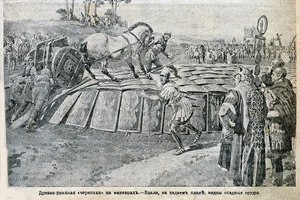 Scutums in battle formation “tortoise” on the image of “Maneuvers of Roman army” from the magazine “Nature and people”, 1915
Scutums in battle formation “tortoise” on the image of “Maneuvers of Roman army” from the magazine “Nature and people”, 1915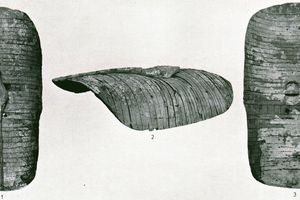 Faiyum scutum. The end of II century, beginning of I century BCE. Found in 1900, Faiyum oasis, near Kasr El Harit. Citadel of Cairo
Faiyum scutum. The end of II century, beginning of I century BCE. Found in 1900, Faiyum oasis, near Kasr El Harit. Citadel of Cairo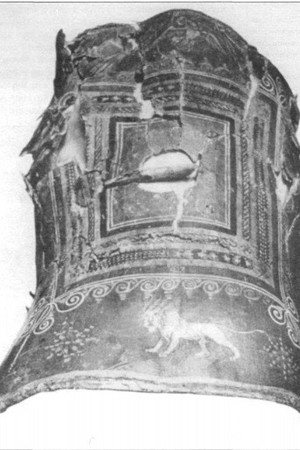 Scutum from Dura-Europos (III century CE) after restoration. Found around 1930, near Dura-Europos. The shield is reposited in art gallery of Weles’ University
Scutum from Dura-Europos (III century CE) after restoration. Found around 1930, near Dura-Europos. The shield is reposited in art gallery of Weles’ University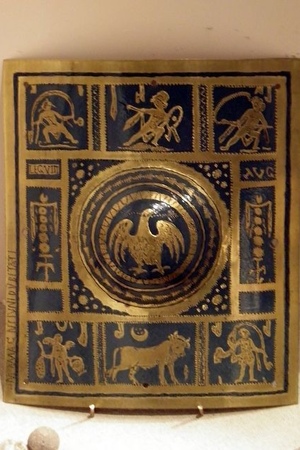 Decorated Umbo Legio VIII Augusta. First half Second century II CE. Found in Britain, River Tyne. British museum
Decorated Umbo Legio VIII Augusta. First half Second century II CE. Found in Britain, River Tyne. British museum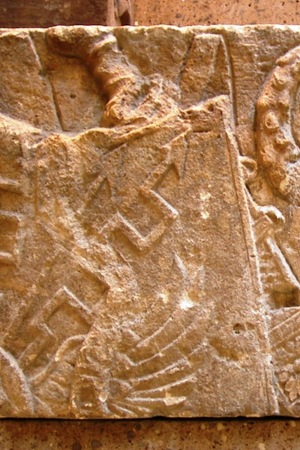 Fragment of the monument depicting scutum with digma. I BCE – III CE, Roman-Germanic Museum, Cologne
Fragment of the monument depicting scutum with digma. I BCE – III CE, Roman-Germanic Museum, Cologne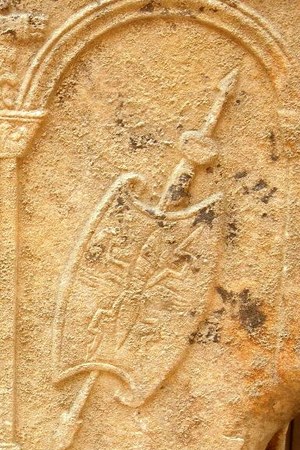 Depiction of the scutum with curved edges on a funeral stele of Gaus Samius Krescen, the soldier of XII city cohort. The stell was erected by his brother Fortis, soldier of VIII pretorians cohort. 1 century BCE – III century CE, museum of Moderna
Depiction of the scutum with curved edges on a funeral stele of Gaus Samius Krescen, the soldier of XII city cohort. The stell was erected by his brother Fortis, soldier of VIII pretorians cohort. 1 century BCE – III century CE, museum of Moderna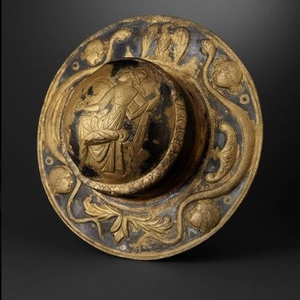 Round brass umbo whith the remains os silvering and guilding. III century CE. Found presumably in lower part of Danube. Reposited in private collection of Axel Gutmann
Round brass umbo whith the remains os silvering and guilding. III century CE. Found presumably in lower part of Danube. Reposited in private collection of Axel Gutmann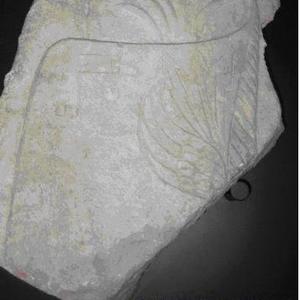 Stone fragment of the ancient gate of Porta Ticinese in Milan, depicting a shield with wings, lightning and L-shaped ornament (gammadia) in the corner, I-th century BCE-III-th century CE, Museum of Arechology of Milan
Stone fragment of the ancient gate of Porta Ticinese in Milan, depicting a shield with wings, lightning and L-shaped ornament (gammadia) in the corner, I-th century BCE-III-th century CE, Museum of Arechology of Milan 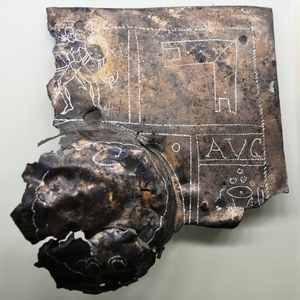 Fragment of an umbo with a square plate made of bronze, dating from the II century CE. It is 18.3 cm wide and decorated with dots. There is a figure of Mars on top , in the corner is the decoration with letter "L" (gammadia), usually used to strengthen the corners of shields, and on the right ther are the initials "AUG", referring to the Legio Augustus, Vindonissa Museum
Fragment of an umbo with a square plate made of bronze, dating from the II century CE. It is 18.3 cm wide and decorated with dots. There is a figure of Mars on top , in the corner is the decoration with letter "L" (gammadia), usually used to strengthen the corners of shields, and on the right ther are the initials "AUG", referring to the Legio Augustus, Vindonissa Museum